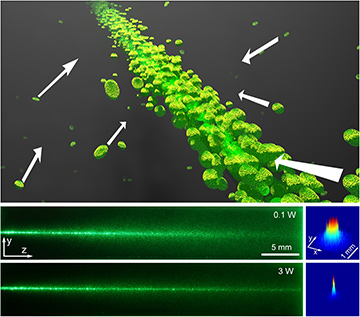 Top: Illustration of bacteria drawn inward and forward by a light beam, creating an effective waveguide that helps compensate for the beam’s natural diffraction (see online video). Bottom left: Side view of a laser beam propagating in marine Synechococcus cells suspended in seawater. At low power, the beam shows linear diffraction/scattering; at high power, it experiences nonlinear self-trapping. Bottom right: Corresponding 3-D plots of the beam profiles after 4 cm of propagation, captured by a CCD camera.
Top: Illustration of bacteria drawn inward and forward by a light beam, creating an effective waveguide that helps compensate for the beam’s natural diffraction (see online video). Bottom left: Side view of a laser beam propagating in marine Synechococcus cells suspended in seawater. At low power, the beam shows linear diffraction/scattering; at high power, it experiences nonlinear self-trapping. Bottom right: Corresponding 3-D plots of the beam profiles after 4 cm of propagation, captured by a CCD camera.
Understanding light interaction with living cells holds crucial importance for the development of bio-imaging, biofuels, bio-lasers, and bio-optical microchips, and for a deep understanding of biophotonics, optofluidics and soft-matter physics. Yet, although nonlinear self-action of light has been demonstrated in colloidal suspensions of stiff nanoparticles,1–4 the nonlinear response of biological media has not been truly investigated so far. In fact, it is commonly assumed that light cannot penetrate deeply into biological environments because of those environments’ strong scattering and absorption loss and weak optical nonlinearity.
We recently demonstrated the surprising existence of a significant nonlinear response in microorganisms, involving both robust self-trapping and enhanced transmission of a light beam through a biological suspension of marine bacteria.5 In the same work, we also observed similar nonlinear effects in suspensions containing other types of living cells, including human red blood cells. By deliberately altering the cyanobacteria’s host environment, we demonstrated a dramatic change of the nonlinear dynamics associated with light propagation.5 Remarkably, the microorganisms remained viable during this process.
To explain the microorganism behavior and the formation of “biological” optical waveguides, we developed a forward-scattering theoretical model. The model showed that a nonlocal nonlinearity, mediated by the combined optical forces acting on the bacteria, is instrumental toward creating living waveguides of light. We found that the scattering force arising from light traveling in the forward direction appears to play a pivotal role in forming the waveguide channel by sustaining needle-like light propagation through the biological suspensions.
The finding that cells can survive at high power levels and create waveguides promises interesting applications in medicine and biology. Bio-soft-matter systems with tunable optical nonlinearities, optical conduits in biological suspensions and the possibility of nonlinear imaging through biological fluids are only a few examples.
Researchers
Anna Bezryadina, Rekha Gautam, Graham Siggins, Andrew Kalmbach, Josh Lamstein, Daniel Gallardo, Edward J. Carpenter and Andrew Ichimura, San Francisco State University, Calif., USA
Tobias Hansson, INRS, Université du Québec, Canada
Benjamin Wetzel, INRS, Université du Québec, and University of Sussex, Brighton, U.K.
Daryl Preece, University of California, San Diego, Calif., USA
Roberto Morandotti, INRS, Université du Québec, University of Electronic Science and Technology of China, Chengdu, China, and National Research University of Information Technologies, St. Petersburg, Russia
Zhigang Chen, Nankai University, Tianjin, China, and San Francisco State University, Calif., USA
References
1. W. Man et al. Phys. Rev. Lett. 111, 218302 (2013).
2. E. Greenfield et al. Opt. Express 21, 23785 (2013).
3. T.S. Kelly et al. Opt. Lett. 41, 3817 (2016).
4. C. Conti et al. Phys. Rev. Lett. 95, 183902 (2005).
5. A. Bezryadina et al. Phys. Rev. Lett. 119, 058101 (2017).
